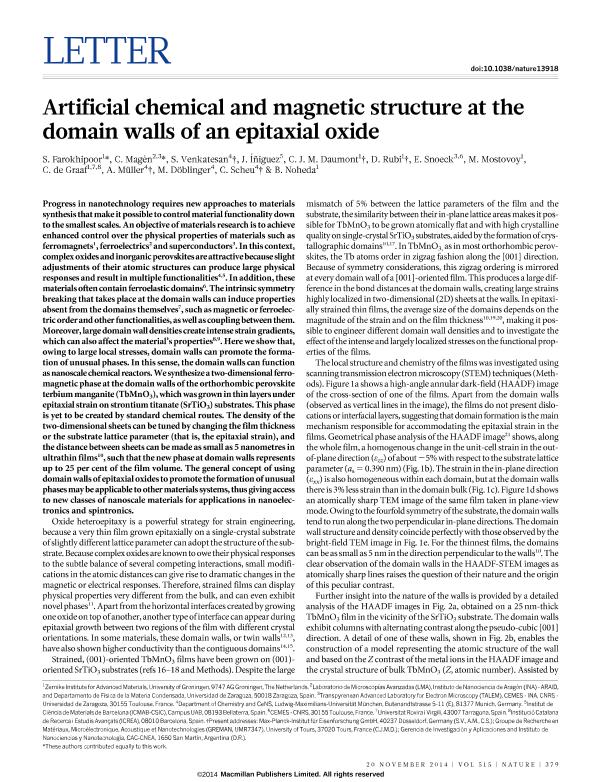Artículo
Artificial chemical and magnetic structure at the domain walls of an epitaxial oxide
Farokhipoor, S.; Magén, C.; Venkatesan, S.; Íñiguez, J.; Daumont, C.J.M.; Rubi, Diego ; Snoeck, E.; Mostovoy, M.; De Graaf, C.; Müller, A.; Döblinger, M.; Scheu, C.; Noheda, B.
; Snoeck, E.; Mostovoy, M.; De Graaf, C.; Müller, A.; Döblinger, M.; Scheu, C.; Noheda, B.
 ; Snoeck, E.; Mostovoy, M.; De Graaf, C.; Müller, A.; Döblinger, M.; Scheu, C.; Noheda, B.
; Snoeck, E.; Mostovoy, M.; De Graaf, C.; Müller, A.; Döblinger, M.; Scheu, C.; Noheda, B.
Fecha de publicación:
11/2014
Editorial:
Nature Publishing Group
Revista:
Nature
ISSN:
0028-0836
Idioma:
Inglés
Tipo de recurso:
Artículo publicado
Clasificación temática:
Resumen
Progress in nanotechnology requires new approaches to materials synthesis that make it possible to control material functionality down to the smallest scales. An objective of materials research is to achieve enhanced control over the physical properties of materials such as ferromagnets1, ferroelectrics2 and superconductors3. In this context, complex oxides and inorganic perovskites are attractive because slight adjustments of their atomic structures can produce large physical responses and result in multiple functionalities4,5. In addition, these materials often contain ferroelastic domains6. The intrinsic symmetry breaking that takes place at the domain walls can induce properties absent from the domains themselves7, such as magnetic or ferroelectric order and other functionalities, as well as coupling between them. Moreover, large domain wall densities create intense strain gradients, which can also affect the material’s properties8,9. Here we show that, owing to large local stresses, domain walls can promote the formation of unusual phases. In this sense, the domain walls can function as nanoscale chemical reactors. We synthesize a two-dimensional ferromagnetic phase at the domain walls of the orthorhombic perovskite terbium manganite (TbMnO3), which was grown in thin layers under epitaxial strain on strontium titanate (SrTiO3) substrates. This phase is yet to be created by standard chemical routes. The density of the two-dimensional sheets can be tuned by changing the film thickness or the substrate lattice parameter (that is, the epitaxial strain), and the distance between sheets can be made as small as 5 nanometres in ultrathin films10, such that the new phase at domain walls represents up to 25 per cent of the film volume. The general concept of using domain walls of epitaxial oxides to promote the formation of unusual phases may be applicable to other materials systems, thus giving access to new classes of nanoscale materials for applications in nanoelectronics and spintronics.
Palabras clave:
Thin Films
,
Manganites
,
Domain Walls
,
Ferromagnetism
Archivos asociados
Licencia
Identificadores
Colecciones
Articulos(SEDE CENTRAL)
Articulos de SEDE CENTRAL
Articulos de SEDE CENTRAL
Citación
Farokhipoor, S.; Magén, C.; Venkatesan, S.; Íñiguez, J.; Daumont, C.J.M.; et al.; Artificial chemical and magnetic structure at the domain walls of an epitaxial oxide; Nature Publishing Group; Nature; 515; 11-2014; 379-383
Compartir
Altmétricas



